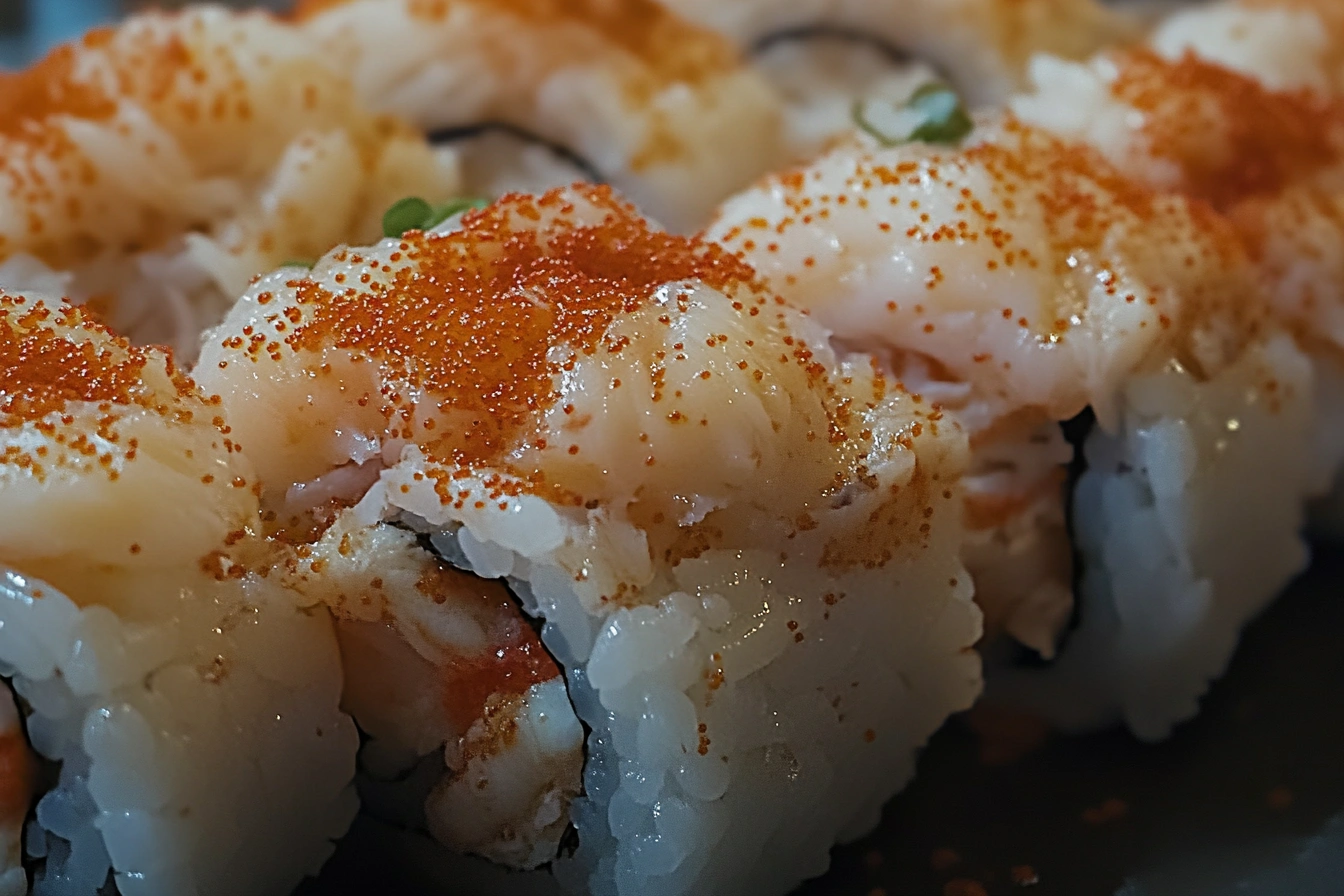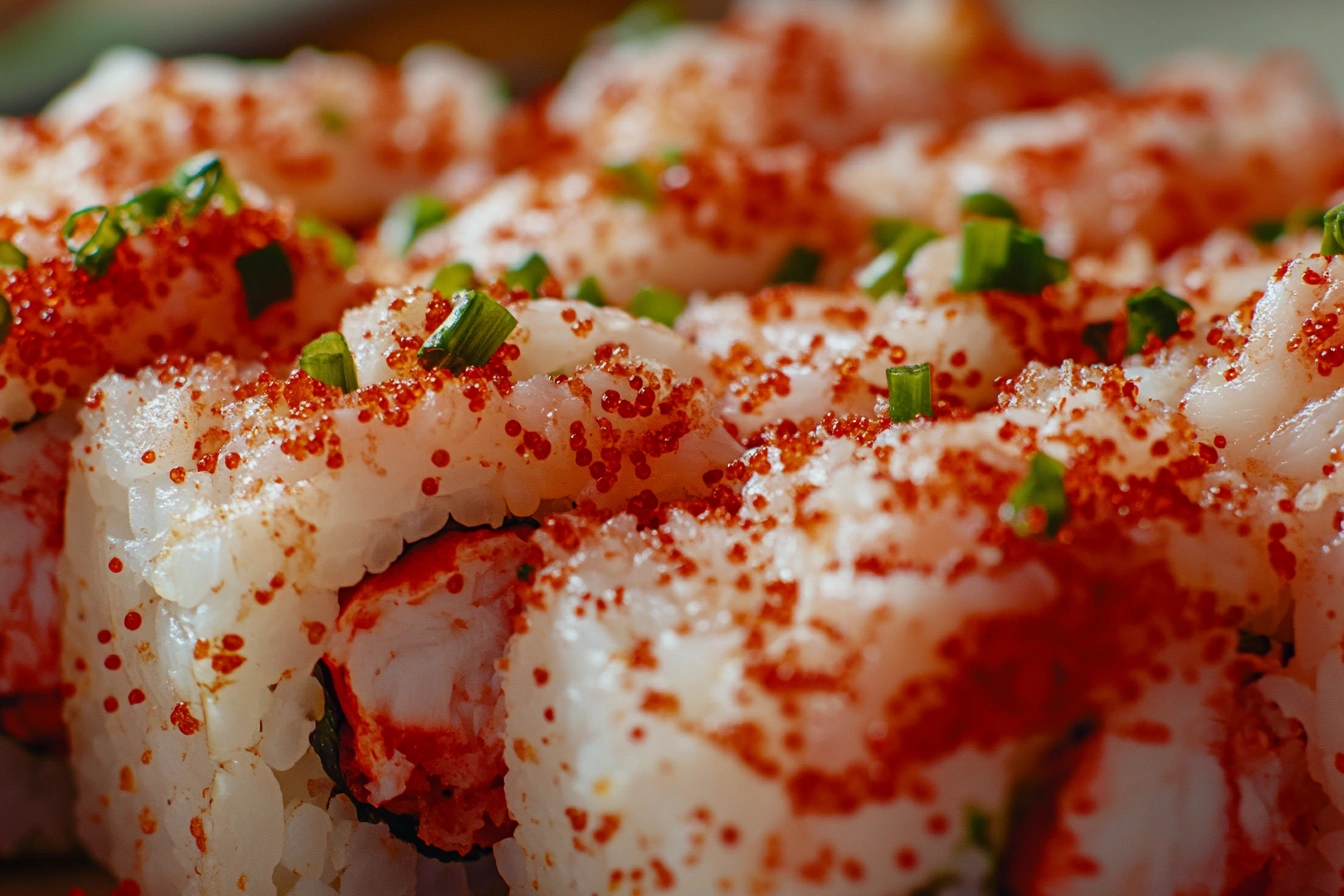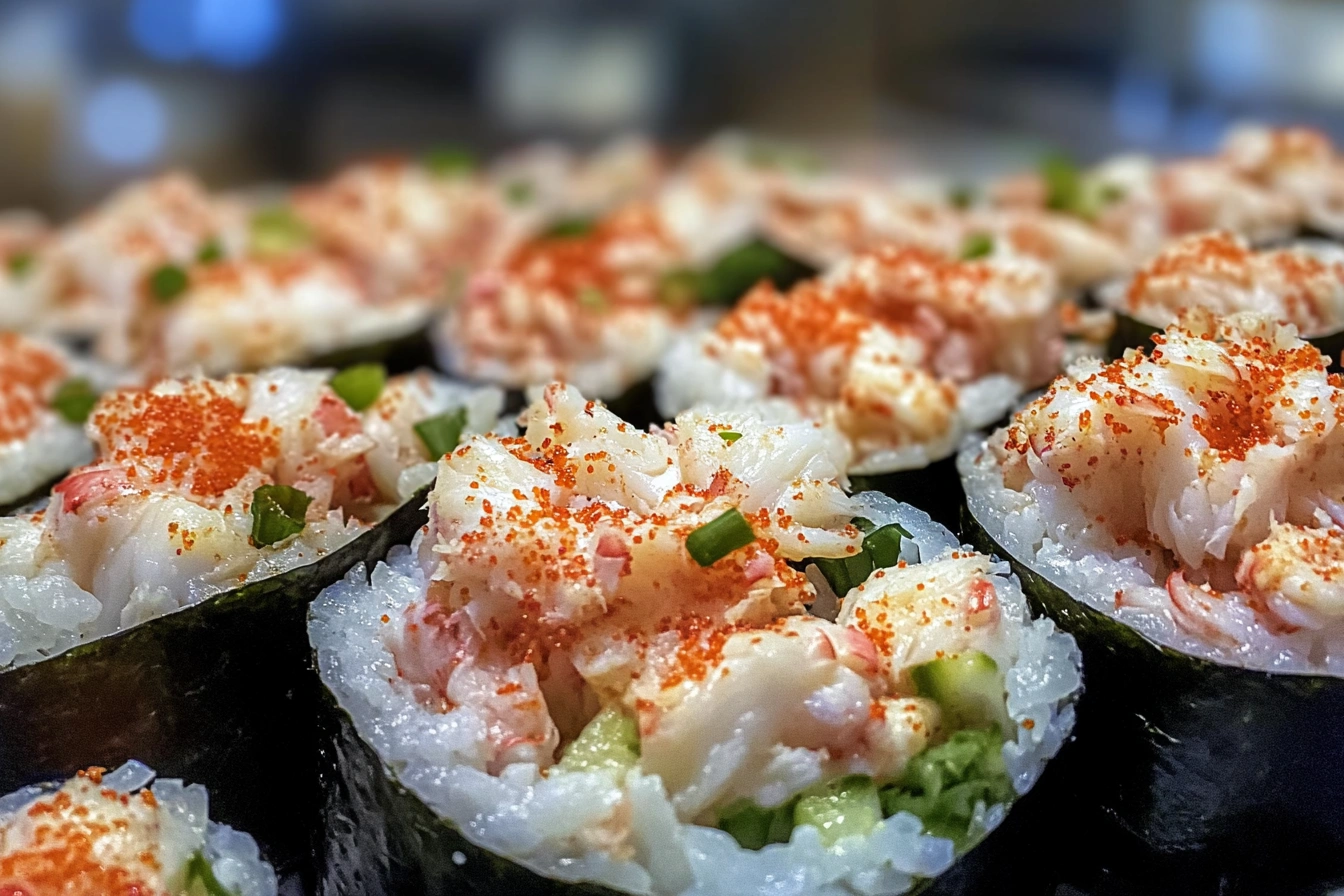Understanding the Nutritional Value of Spicy Crab
Spicy crab is a popular seafood dish found in sushi, salads, and various international cuisines. While it is often considered a tasty and satisfying option, its nutritional value depends on whether real or imitation crab is used. Additionally, ingredients like spicy mayo and soy sauce can significantly impact its overall healthiness. In this section, we will explore what spicy crab is, its nutritional breakdown, and its potential health benefits.
Table of Contents
1.1 What Is Spicy Crab?
Spicy crab refers to a seafood dish made from either real or imitation crab, typically combined with spicy seasonings, mayonnaise, or sauce. The most common variations include:
✔ Spicy Crab Sushi Roll
- One of the most popular sushi rolls, made with imitation crab, sushi rice, spicy mayo, and seaweed (nori).
- It has a creamy, slightly spicy flavor that makes it a favorite among sushi lovers.
✔ Spicy Crab Salad
- Made by shredding real or imitation crab and mixing it with spicy mayo, cucumbers, and sesame seeds.
- Often served as a side dish, in sushi bowls, or as a topping for poke bowls.
✔ Spicy Korean Crab (Yangnyeom Gejang)
- A traditional Korean dish made with raw blue crab marinated in a spicy, savory sauce.
- The sauce includes gochugaru (Korean red chili flakes), soy sauce, garlic, and sugar.
- Unlike other spicy crab dishes, this version is eaten raw and has a rich umami flavor.
🔹 Key Ingredients That Impact Health
1️⃣ Real vs. Imitation Crab
- Real crab is naturally rich in protein, omega-3s, and essential nutrients.
- Imitation crab (surimi) is a processed seafood product made from white fish, starch, and flavoring, making it lower in nutrients.
2️⃣ Spicy Mayo
- A blend of mayonnaise and sriracha, spicy mayo adds significant calories and fat to the dish.
- Some healthier alternatives include Greek yogurt or avocado-based sauces.
3️⃣ Seasonings & Sodium Content
- Soy sauce, gochujang, and other seasonings can make spicy crab high in sodium, which may not be ideal for people with high blood pressure or heart conditions.
🔹 Key Takeaway: Spicy crab can be a flavorful and satisfying dish, but its nutritional value varies based on the ingredients used. Choosing real crab and lighter sauces can make it a healthier option.
1.2 Nutritional Breakdown of Spicy Crab
The nutritional value of spicy crab depends on whether real or imitation crab is used. Below is a comparison of the two:
| Nutrient | Imitation Crab (per 100g) | Real Crab (per 100g) |
|---|---|---|
| Calories | 95 kcal | 87 kcal |
| Protein | 7g | 18g |
| Fat | 0.5g | 1g |
| Carbohydrates | 15g | 0g |
| Omega-3 Fatty Acids | Low | High |
| Sodium | High | Moderate |
🔹 Key Nutritional Differences
✔ Protein Content:
- Real crab is significantly higher in protein (18g per 100g) compared to imitation crab (7g per 100g).
- This makes real crab a better choice for muscle growth and overall nutrition.
✔ Carbohydrates & Processing:
- Real crab contains zero carbohydrates, whereas imitation crab has around 15g per 100g due to added starches.
- The extra starches in imitation crab make it a less ideal option for low-carb or keto diets.
✔ Omega-3 Fatty Acids:
- Real crab is rich in omega-3s, which are essential for heart and brain health.
- Imitation crab lacks these essential fatty acids since it is made from processed fish.
✔ Sodium Levels:
- Imitation crab contains significantly more sodium than real crab, which can contribute to high blood pressure and water retention.
- People on low-sodium diets should opt for real crab and avoid highly processed imitation crab.
✔ Spicy Mayo & Extra Calories:
- Adding spicy mayo to spicy crab dishes increases the calorie count significantly.
- A tablespoon of spicy mayo can add 90-100 extra calories to the dish.
- Using healthier alternatives like Greek yogurt or avocado-based sauces can help reduce calories.
🔹 Key Takeaway: Real crab is more nutritious than imitation crab, offering more protein and omega-3s with fewer processed ingredients. However, spicy mayo and high-sodium seasonings can impact the overall healthiness of the dish.
1.3 Health Benefits of Eating Spicy Crab
Despite variations in nutritional value, spicy crab—especially when made with real crab—can offer several health benefits.
✔ High Protein Content
- Real crab contains up to 18g of protein per 100g, making it a great source of lean protein.
- Protein helps with muscle growth, satiety, and metabolism regulation.
- Even imitation crab, though lower in protein, still provides some protein benefits.
✔ Rich in Essential Nutrients
- Real crab is packed with essential vitamins and minerals, including:
- Vitamin B12 – Supports nerve function and red blood cell production.
- Selenium – Acts as an antioxidant and helps boost the immune system.
- Zinc & Copper – Important for immune health and energy production.
- Imitation crab, on the other hand, has fewer essential nutrients due to its processing.
✔ Low in Saturated Fat
- Both real and imitation crab are relatively low in saturated fat, making them better choices than red meats or fried seafood.
- When not combined with heavy sauces, spicy crab can be a lean and healthy protein option.
✔ Good for Brain & Heart Health
- Real crab is high in omega-3 fatty acids, which support:
- Heart health by reducing inflammation and lowering bad cholesterol.
- Brain function and cognitive development.
- Imitation crab, however, lacks these omega-3s due to its processed nature.
🔹 Key Takeaway: Spicy crab, especially when made with real crab, can be a nutritious option rich in protein, vitamins, and omega-3s. However, imitation crab is more processed and contains fewer essential nutrients.

Health Risks, Comparisons, and Dietary Considerations
While spicy crab can be a delicious and satisfying dish, its healthiness depends on the ingredients used. The combination of processed imitation crab, high-sodium seasonings, and spicy mayo can make it less ideal for certain diets. This section explores the potential health risks, comparisons with other seafood, and whether spicy crab fits into different diets.
2.1 Is Spicy Crab Unhealthy?
The nutritional value of spicy crab varies significantly depending on whether real or imitation crab is used. While real crab offers protein, vitamins, and omega-3 fatty acids, spicy crab dishes often contain processed ingredients, added sodium, and high-fat condiments.
🚫 Health Concerns with Spicy Crab
1️⃣ High in Sodium
- Imitation crab is particularly high in sodium, often containing 500-900 mg per 100g.
- Soy sauce and other seasonings can further increase sodium intake, which may be a concern for people with high blood pressure or heart conditions.
2️⃣ Processed Ingredients in Imitation Crab
- Contains starches, preservatives, and artificial flavors to mimic the texture and taste of real crab.
- Lower in protein and essential nutrients than real crab.
3️⃣ Spicy Mayo Adds Extra Calories
- A single tablespoon of spicy mayo can add 90-100 extra calories to a dish.
- Mayo is high in saturated fat, which can contribute to weight gain if consumed in excess.
✔ Tips to Make Spicy Crab Healthier
✔ Use Real Crab Instead of Imitation
- Higher in protein and omega-3s for better nutrition.
✔ Reduce or Replace Spicy Mayo
- Substitute Greek yogurt or avocado-based sauces for a lower-calorie alternative.
✔ Opt for Low-Sodium Soy Sauce
- Reducing sodium intake helps maintain heart health and fluid balance.
🔹 Key Takeaway: Spicy crab can be high in sodium and processed ingredients, but healthier versions can be made by using real crab and lighter sauces.
2.2 How Spicy Crab Compares to Other Seafood
How does spicy crab stack up against other common seafood options? Here’s a nutritional comparison:
🔹 Nutritional Comparison of Spicy Crab vs. Other Seafood
| Seafood | Protein (per 100g) | Calories | Omega-3s | Sodium |
|---|---|---|---|---|
| Spicy Crab (Imitation) | 7g | 95 kcal | Low | High |
| Real Crab | 18g | 87 kcal | High | Moderate |
| Salmon | 20g | 180 kcal | Very High | Low |
| Shrimp | 20g | 85 kcal | Moderate | Low |
| Tuna | 25g | 120 kcal | High | Moderate |
✔ Key Differences
✔ Protein Content:
- Real crab, shrimp, salmon, and tuna are all much higher in protein than imitation crab.
- Tuna has the highest protein content, making it an excellent lean protein source.
✔ Omega-3 Fatty Acids:
- Salmon and tuna contain significantly more omega-3s than crab.
- Real crab provides a moderate amount of omega-3s, while imitation crab has very little.
✔ Sodium Levels:
- Imitation crab has the highest sodium content, while salmon and shrimp are naturally low in sodium.
🔹 Key Takeaway: If looking for a healthier seafood option, choose real crab, shrimp, or salmon over imitation crab.
2.3 Can You Eat Spicy Crab on a Diet?
Spicy crab can be included in a healthy diet, but it depends on the portion size and added ingredients.
✔ Pros for Dieting:
✔ Low in Calories (Without Mayo)
- A spicy crab roll without mayo can be under 200 calories, making it a light meal.
✔ High in Protein Helps with Satiety
- Protein in crab keeps you full longer, helping with weight management.
🚫 Potential Dieting Concerns:
🚫 Hidden Calories from Spicy Mayo & Sushi Rice
- Spicy mayo and rice increase the calorie count, making it less suitable for strict low-calorie diets.
🚫 Is Spicy Crab Keto-Friendly?
✔ Real crab is keto-friendly since it is low in carbs.
🚫 Imitation crab is NOT keto-friendly due to the added starches, which contain 10-15g of carbs per serving.
✔ Tips to Keep Spicy Crab Diet-Friendly:
✔ Order or Make Spicy Crab with Less Rice – Reduces carbs and overall calorie intake.
✔ Use Real Crab Instead of Imitation Crab – Higher protein and no added starches.
✔ Swap Spicy Mayo for Healthier Alternatives – Try avocado or Greek yogurt-based sauces.
🔹 Key Takeaway: Spicy crab can fit into a healthy diet if portion sizes and added ingredients are controlled.
2.4 Is Spicy Crab Safe for Everyone?
While spicy crab is safe for most people, there are some exceptions to keep in mind.
🚫 Allergy Risks
- Both real and imitation crab can trigger shellfish allergies.
- People with seafood allergies should avoid spicy crab and check ingredient labels for hidden allergens.
🚫 Pregnancy Concerns
✔ Spicy Crab Sushi is Safe for Pregnancy If Made with Fully Cooked Crab
- Pregnant women should avoid raw seafood, but cooked crab is safe.
🚫 Avoid Raw Spicy Crab Dishes Like Yangnyeom Gejang
- Raw seafood can carry bacteria and parasites, which can be dangerous during pregnancy.
✔ Low-Mercury Seafood Option
- Unlike tuna, which can have high mercury levels, crab is a safer choice for pregnant women and children.
✔ Tips for Safe Consumption:
✔ Choose cooked crab over raw seafood if pregnant.
✔ Avoid spicy crab dishes if allergic to shellfish.
✔ Check labels for added preservatives if you have food sensitivities.
🔹 Key Takeaway: Spicy crab is safe for most people, but those with seafood allergies or high sodium concerns should be cautious.

FAQs – People Also Ask
Spicy crab is a popular dish, but many people have questions about its health benefits, calorie content, and whether it fits into different diets. Below are answers to some of the most commonly asked questions about spicy crab.
Is Spicy Crab Healthy?
✔ It can be healthy in moderation, especially when made with real crab.
- Real crab is high in protein, omega-3 fatty acids, and essential vitamins like B12 and selenium.
- When paired with lighter sauces and fresh ingredients, it can be a nutritious seafood choice.
🚫 Imitation crab is processed and high in sodium, making it less nutritious than real crab.
- It contains added starches, preservatives, and artificial flavors.
- Higher sodium content can contribute to water retention and increased blood pressure.
🔹 Key Takeaway: Spicy crab can be a healthy meal option, but choosing real crab over imitation and reducing high-fat sauces can improve its nutritional value.
Does Spicy Crab Have a Lot of Calories?
✔ A basic spicy crab roll (without extra mayo) has around 200-300 calories.
- A standard spicy crab roll made with sushi rice, imitation crab, and a small amount of spicy mayo is relatively low in calories.
🚫 Adding spicy mayo and tempura toppings can increase calories significantly.
- A tablespoon of spicy mayo adds around 90-100 extra calories.
- Deep-fried tempura versions can push the calorie count well above 400-500 calories per roll.
🔹 Key Takeaway: Spicy crab can be a moderate-calorie dish, but added sauces and fried toppings can increase its calorie content significantly.
Is Spicy Crab Good for Weight Loss?
✔ It is low in fat and high in protein, making it a good weight-loss food.
- Protein helps with muscle maintenance and satiety, reducing hunger cravings.
- Low-fat seafood options like real crab support a balanced diet.
🚫 Sushi rice and mayo can add extra carbs and fats, so portion control is key.
- White sushi rice is high in carbohydrates, which can affect blood sugar levels.
- Mayo-based sauces add unnecessary fats that can slow down weight loss efforts.
Tips to Make Spicy Crab More Weight-Loss Friendly:
✔ Opt for real crab instead of imitation for higher protein and fewer carbs.
✔ Reduce or replace spicy mayo with Greek yogurt or avocado-based sauce.
✔ Choose brown rice or lettuce wraps instead of white sushi rice.
🔹 Key Takeaway: Spicy crab can be part of a weight-loss diet if portion sizes are controlled and heavy sauces are minimized.
Can You Eat Spicy Crab on a Keto Diet?
✔ Real crab is keto-friendly.
- Naturally low in carbs and high in protein, making it an excellent choice for a ketogenic diet.
- Pair it with avocado, cucumber, and seaweed for a low-carb meal.
🚫 Imitation crab is not keto-friendly because it contains added starches and carbohydrates.
- Imitation crab typically contains 10-15g of carbs per serving due to added starches and sugars.
- This makes it unsuitable for strict low-carb or keto diets.
How to Make Spicy Crab Keto-Friendly:
✔ Use real crab instead of imitation crab.
✔ Replace sushi rice with cauliflower rice or serve in lettuce wraps.
✔ Use a keto-friendly mayo without added sugars.
🔹 Key Takeaway: If following a keto diet, avoid imitation crab and opt for real crab with low-carb ingredients.
Is Spicy Crab Safe for Pregnancy?
✔ Yes, as long as the crab is fully cooked and not raw.
- Cooked crab is safe for pregnant women and provides essential nutrients like protein and omega-3s.
- Sushi rolls made with fully cooked crab (like spicy crab rolls) are safe to consume during pregnancy.
🚫 Avoid raw spicy crab dishes like Yangnyeom Gejang during pregnancy.
- Raw seafood can carry harmful bacteria and parasites that pose risks to the baby’s health.
- Korean spicy raw crab (Yangnyeom Gejang) and raw seafood sushi should be avoided.
Best Ways to Enjoy Spicy Crab During Pregnancy:
✔ Choose fully cooked spicy crab sushi rolls.
✔ Make spicy crab salad with real, cooked crab.
✔ Opt for homemade versions to control ingredient quality.
🔹 Key Takeaway: Spicy crab is safe for pregnant women if made with fully cooked crab, but raw seafood versions should be avoided.
Final Thoughts
✔ Spicy crab can be a healthy and delicious option, especially when made with real crab.
✔ Calorie content varies depending on added sauces, fried toppings, and portion sizes.
✔ It can fit into weight-loss and keto diets with some ingredient modifications.
✔ Pregnant women can enjoy spicy crab as long as it is fully cooked and not raw.

